Understanding creatine kinase is key to staying healthy. It’s a muscle enzyme found mainly in muscles. High or low levels can show muscle damage or disease. A test for creatine kinase is important for doctors to diagnose and track health.

The normal range for creatine kinase varies slightly by lab. But it’s usually in specific units per liter of blood. Knowing this range helps doctors understand test results and what they mean for your health. By knowing about creatine kinase and its role in muscle health, you can take steps to keep your levels healthy. Regular tests can catch problems early, helping you get the right treatment fast.
Key Takeaways
- Creatine kinase is a muscle enzyme that can indicate muscle damage or disease.
- A creatine kinase test can help diagnose and monitor various health conditions.
- Abnormal creatine kinase levels can have significant health implications.
- Regular monitoring of creatine kinase levels is essential for maintaining healthy levels.
- Knowing the normal range for creatine kinase is important for interpreting test results.
- Creatine kinase plays a vital role in muscle health, and its levels can be influenced by various factors, including diet and physical activity.
What Is Creatine Kinase and Its Role in the Body
Creatine kinase is an enzyme that helps muscles make energy. It turns creatine and ATP into phosphocreatine and ADP. This is key for quick energy in muscle contractions.
In muscle tissue, it helps move phosphate groups from ATP to creatine. This makes phosphocreatine, a high-energy compound. It’s used to quickly refill ATP stores during hard muscle work. The enzyme functions of creatine kinase are essential for muscle function and physical performance.
Primary Functions in Muscle Tissue
Creatine kinase is most found in skeletal muscle, heart muscle, and brain. Its main job is to turn creatine and ATP into phosphocreatine and ADP. This gives muscles a quick energy source for contractions.
Different Types of Creatine Kinase
There are several types of creatine kinase, including:
- CK-MM: mainly in skeletal muscle
- CK-MB: mainly in heart muscle
- CK-BB: originally in the brain; mostly from smooth muscles in blood
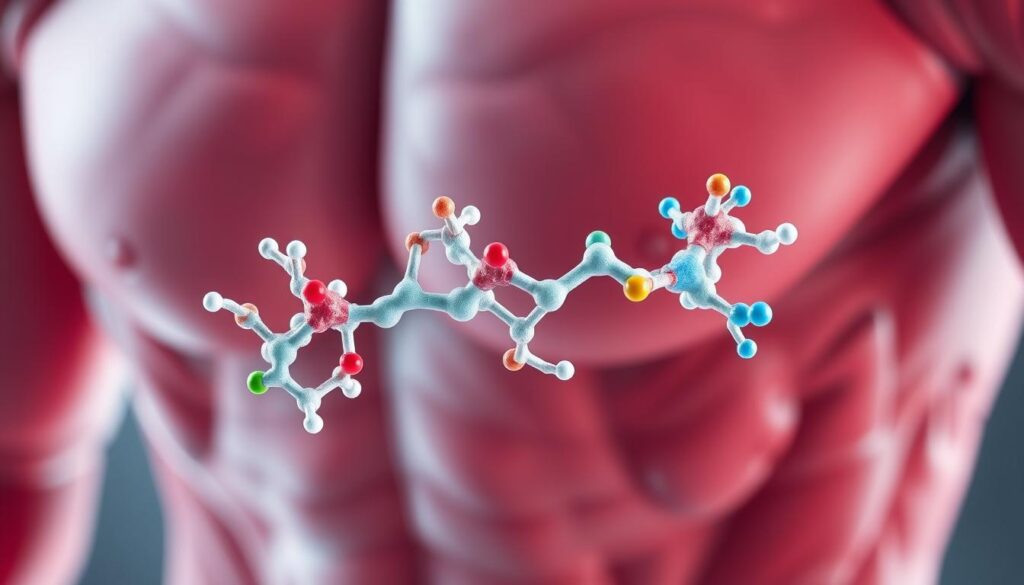
Knowing about the different types of creatine kinase is key. It shows how important this enzyme is for muscle function and health.
The Importance of Monitoring Creatine Kinase Levels
It’s key to watch creatine kinase levels for health monitoring. High levels can show muscle damage. This enzyme is a key marker for muscle disorders.
Changes in creatine kinase levels show how much muscle is injured. They also show how diseases progress. This makes it important for doctors to check these levels.
Checking creatine kinase levels often can spot problems early. For example, muscle damage from hard workouts can be seen. This helps adjust workouts to avoid more harm.
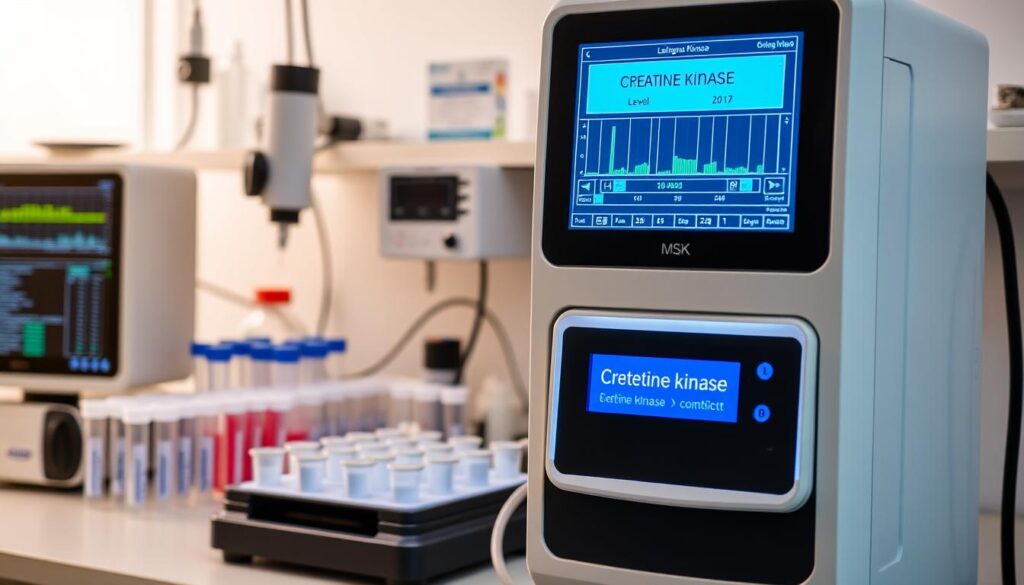
It’s also vital for people with certain health issues. High levels can mean heart attacks, muscular dystrophy, or other muscle diseases. Regular checks help manage health and avoid serious problems.
Here are some important things to remember about creatine kinase levels:
- Normal levels can change based on age, gender, and ethnicity
- High levels mean muscle cell death and damage
- Hard workouts, like weightlifting, can really raise creatine kinase levels
Understanding Creatine Kinase Normal Range
The normal range for creatine kinase, also known as creatine phosphokinase (CPK), changes with age, gender, and lab. Usually, CPK levels are between 10 to 120 micrograms per liter (mcg/l). But, remember, reference ranges can vary between labs.
When looking at CPK test results, age and gender matter. For example, men often have higher CPK levels because they have more muscle. Physical activity and some health issues can also affect CPK levels.

To grasp the normal range for creatine kinase, it’s good to know the reference ranges used by labs. These ranges help guide how to understand test results. By considering these factors, you can better understand your health and make informed choices.
Standard Reference Ranges
CPK level reference ranges can differ by lab and test type. Here are some general guidelines:
- Normal range: 10-120 mcg/l
- Elevated range: 121-500 mcg/l
- Highly elevated range: above 500 mcg/l
Variations by Age and Gender
CPK levels also vary with age and gender. Here are some general guidelines:
- Males: 50-200 mcg/l
- Females: 30-150 mcg/l
Factors Affecting Creatine Kinase Levels
Creatine kinase levels can change due to physical activity and medical conditions. It’s important to know these factors to understand test results.
Physical activity, like intense exercise, can raise creatine kinase levels. These levels usually go back to normal after a few days of rest. Some medical conditions, like muscle dystrophy, can also change these levels.
Medications can also impact creatine kinase levels. For example, statins, used to lower cholesterol, can increase these levels in some people.

Key Factors to Consider
- Physical activity: Strenuous exercise can cause a temporary increase in creatine kinase levels.
- Medical conditions: Certain conditions, such as muscle dystrophy, can affect creatine kinase levels.
- Medication effects: Statins and other medications can cause an increase in creatine kinase levels.
Knowing these factors helps individuals understand their creatine kinase test results. It also helps them keep these levels healthy.
| Factor | Effect on Creatine Kinase Levels |
|---|---|
| Physical Activity | Temporary increase |
| Medical Conditions | Varying effects |
| Medication Effects | Potential increase |
Signs and Symptoms of Abnormal CK Levels
Abnormal CK levels can show up in many ways, like muscle weakness and pain. They can also lead to serious issues like rhabdomyolysis. It’s key to spot these signs early for quick medical help. Early diagnosis and treatment can help you get better faster and avoid lasting health problems.
Some common signs and symptoms of abnormal CK levels include:
- Muscle pain
- Dark urine
- Feeling weak or tired
These symptoms can look like other issues like heat cramps and dehydration. That makes it hard to figure out what’s wrong just by looking at symptoms. Testing CK levels is a must for a correct diagnosis. You might need to have blood tests done more than once to really know if you have rhabdo.

Abnormal CK levels can also be a sign of other health problems, like muscular dystrophies or myopathies. If you notice any signs or symptoms, see a doctor right away. They can find out what’s causing the problem and treat it.
| Condition | CK Level | Symptoms |
|---|---|---|
| Rhabdomyolysis | High | Muscle pain, dark urine, weakness |
| Muscular Dystrophy | Elevated | Muscle weakness, wasting |
| Myopathy | Abnormal | Muscle pain, weakness |
When to Get Your Creatine Kinase Tested
Creatine kinase testing is key for checking muscle damage and inflammation. It’s often suggested when muscle damage is thought of, like after hard workouts or if you feel weak.
Getting ready for the test is important for good results. You should not do hard exercise or take certain medicines that might mess up the test. Knowing when and how to prepare is vital for those who might need this test.
Common Testing Scenarios
- Muscle weakness or pain
- Recent intense physical activity
- Suspected muscle damage or inflammation
Preparation Requirements
To get precise test results, following the prep steps for creatine kinase testing is key. This means not doing hard exercise for at least 24 hours before and telling your doctor about any meds you’re on.
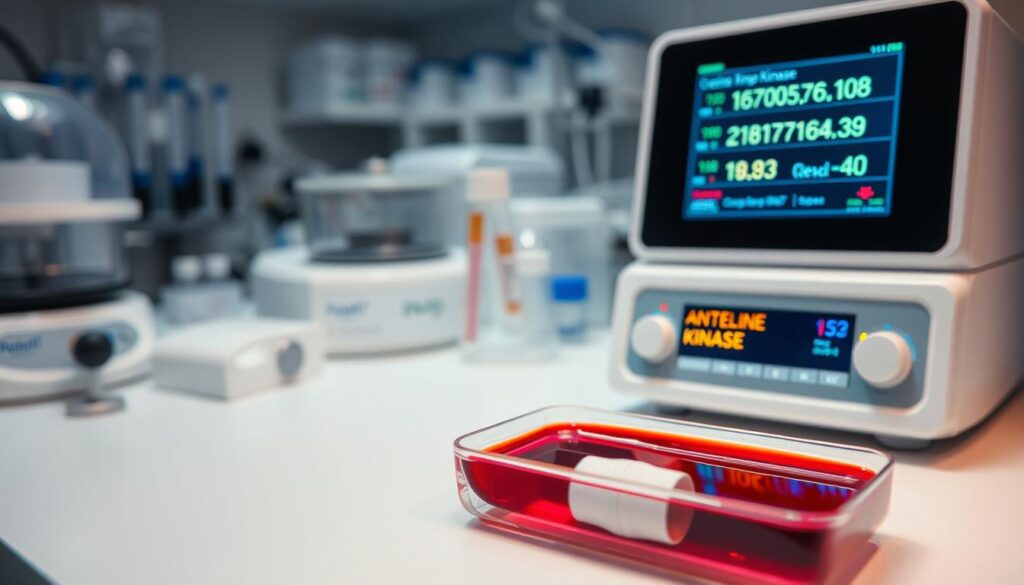
Knowing when and how to prepare for the test helps make sure your results are right. This is important for figuring out and treating muscle problems and stopping more damage.
| Testing Scenario | Preparation Requirement |
|---|---|
| Muscle weakness or pain | Avoid strenuous exercise for 24 hours |
| Recent intense physical activity | Inform doctor about medications |
| Suspected muscle damage or inflammation | Follow doctor’s instructions for preparation |
The Testing Process for Creatine Kinase
The creatine kinase testing process starts with a blood draw. This is then checked for creatine kinase levels. It’s a simple step that helps check muscle health.
A healthcare professional will take a blood sample from your arm. This sample is then sent to a lab for testing.
The creatine kinase testing process is quick, taking just a few minutes. The results come back in a few hours. It’s important to follow the doctor’s instructions for the best results. This includes telling them about any medicines or activities you’ve done recently.

- Blood draw: A healthcare professional draws a blood sample from a vein in the arm.
- Sample preparation: The blood sample is prepared for analysis, which may involve centrifugation or other procedures.
- Analysis: The sample is analyzed for creatine kinase levels using specialized equipment and techniques.
- Results: The results are interpreted by a healthcare professional, who will discuss the findings with the patient.
Knowing about the creatine kinase testing process helps you prepare. By following the doctor’s advice and giving accurate information, you can get the best results. This is the first step to keeping your creatine kinase levels healthy.
Interpreting Your Creatine Kinase Test Results
When you get your creatine kinase test results, it’s key to know how to read them. Interpreting creatine kinase resultsmeans looking at your levels against standard ranges. These ranges can change based on the lab and your age and gender.
A healthcare provider can explain your laboratory reports and what steps to take next. They’ll look at your medical history, symptoms, and physical check-up to fully understand your results.
Here are some important things to think about when looking at your creatine kinase test results:
- Reference ranges: These are the standard ranges used to compare your test results. They can vary depending on the laboratory and the individual’s characteristics.
- Abnormal results: If your test results are outside the reference range, it may indicate a problem, like muscle damage or a heart issue.
- Repeat testing: Sometimes, your healthcare provider might suggest doing the test again to keep an eye on your creatine kinase levels over time.

Understanding your creatine kinase test results and working with a healthcare provider can help you manage your health. This way, you can make smart choices about your care.
High Creatine Kinase: Causes and Implications
High creatine kinase levels can come from muscle injury, hard workouts, or some health issues. Knowing why creatine kinase is high is key for the right treatment. High levels can mean anything from minor muscle damage to serious problems like rhabdomyolysis.
Some common reasons for high creatine kinase include:
- Muscle injury or trauma
- Intense physical activity, such as strenuous exercise
- Certain medical conditions, like muscular dystrophy or hypothyroidism
The effects of high creatine kinase can be big, affecting muscle health and overall health. It’s important to know the causes and effects to give the right care. If you have high creatine kinase, seeing a doctor is a must to find the cause and get treatment.
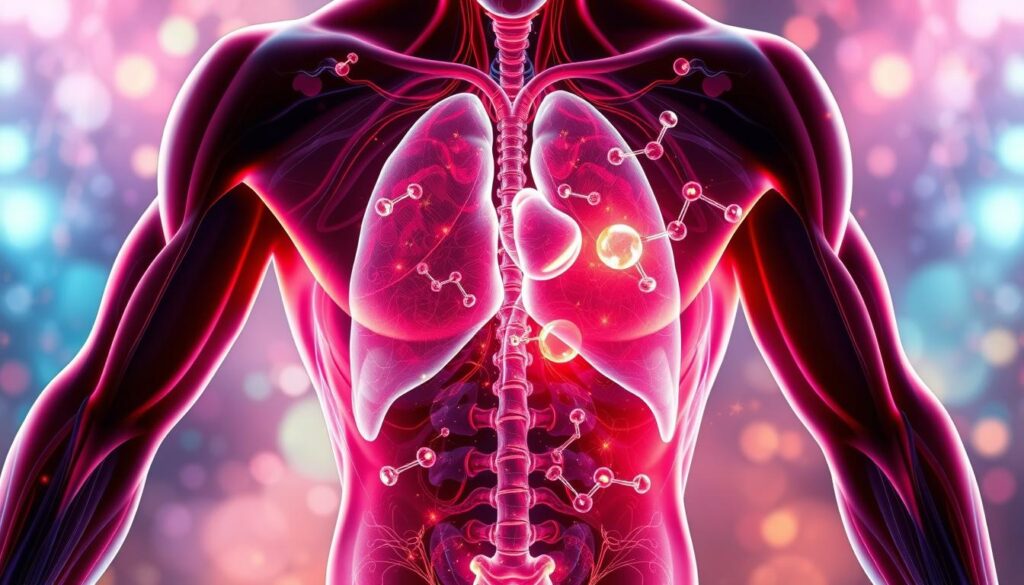
A study on rhabdomyolysis showed creatine kinase levels can go from 10,000 to 200,000 U/L or more. This shows why keeping an eye on high creatine kinase levels is so important. The mean peak levels for different reasons are about 10,000 to 25,000 U/L, showing the need for quick action and treatment.
| Cause | Normal Range | Elevated Range |
|---|---|---|
| Muscle Injury | 40-320 U/L (men), 25-200 U/L (women) | Up to 30 times the upper limit of normal |
| Intense Physical Activity | 40-320 U/L (men), 25-200 U/L (women) | Up to 30 times the upper limit of normal |
| Rhabdomyolysis | 40-320 U/L (men), 25-200 U/L (women) | 10,000 to 200,000 U/L or higher |
Low Creatine Kinase: What It Means
Low creatine kinase levels can have various causes and are linked to certain health issues. It’s important to understand what low creatine kinase levels mean for our health.
Studies have found that low serum creatine kinase (sCK) levels are linked to a higher risk of death. The risk is 1.77 times higher than those with the highest sCK levels. Even after adjusting for other factors, the risk remains 1.37 times higher. This shows that low creatine kinase levels might signal underlying health problems.
Potential Causes and Associated Conditions
Conditions like chronic kidney disease, liver disease, and low muscle mass can lead to low creatine kinase levels. Older adults are also at a higher risk due to muscle loss with age.
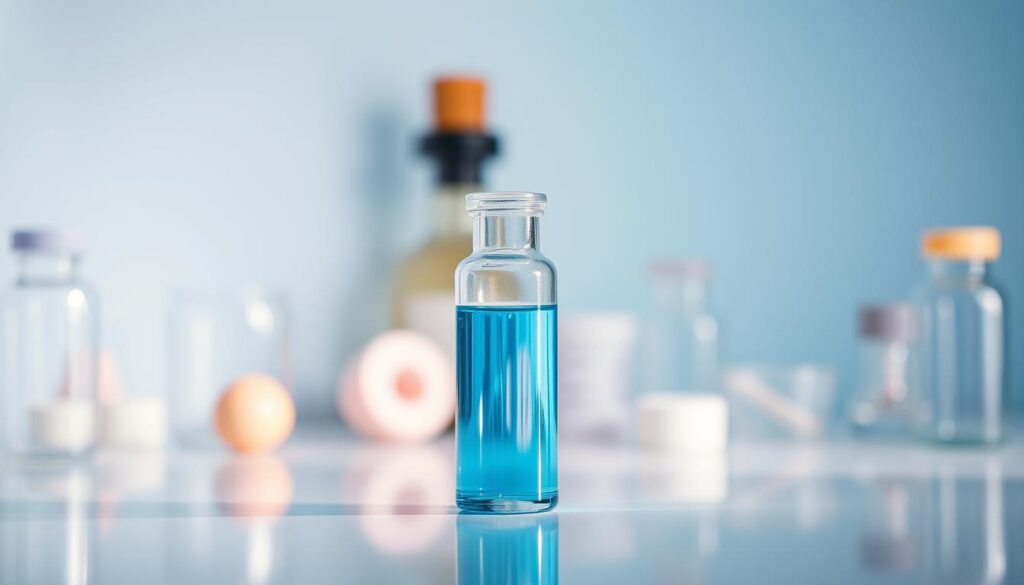
Seeing a healthcare professional is key to figuring out why creatine kinase levels are low. Knowing the causes and associated conditions helps us take care of our health and avoid future problems.
Lifestyle Factors Impacting Creatine Kinase Levels
Regular exercise and a balanced diet are key lifestyle factors that affect creatine kinase levels. Doing cardio or strength training helps keep muscles healthy. A diet rich in protein, complex carbs, and healthy fats also supports muscle health.
A healthy lifestyle with regular exercise and good diet can boost creatine kinase levels. Paying attention to your nutritionand making smart choices helps keep muscles strong. This can lower the chance of muscle problems.

Here are some tips for a healthy lifestyle and creatine kinase levels:
- Do regular physical activities like walking or jogging.
- Eat a balanced diet with all the necessary nutrients.
- Stay hydrated and manage stress well.
Natural Ways to Maintain Healthy CK Levels
Looking into natural ways to keep healthy CK levels is key for muscle health. Changing your diet, using supplements, and making lifestyle changes can help. Eating foods full of antioxidants and omega-3 fatty acids can lessen muscle damage and inflammation. This helps keep healthy CK levels.
Some natural ways to support muscle health include:
- Increasing intake of vitamin D and magnesium
- Consuming anti-inflammatory foods such as turmeric and ginger
- Staying hydrated to help flush out toxins
Regular exercise and enough rest are also vital for healthy CK levels. It’s important to balance activity with rest to prevent muscle damage and inflammation. By adding these natural ways to your daily life, you can keep healthy CK levels and support muscle health.

| Method | Description |
|---|---|
| Dietary Changes | Incorporating foods rich in antioxidants and omega-3 fatty acids |
| Supplements | Increasing intake of vitamin D and magnesium |
| Lifestyle Modifications | Staying hydrated and finding a balance between physical activity and recovery time |
Medical Treatments for Abnormal CK Levels
Abnormal creatine kinase (CK) levels can worry you. But, there are medical treatments to help manage them. The main goal is to find and fix the cause of these levels, which can be muscle damage or certain medicines.
What treatment you get depends on why your CK levels are off. It might include medicine, physical therapy, or other steps. For instance, statins and antipsychotics can raise CK levels, often with muscle damage. Changing your meds or adding supplements can help balance CK levels.
Treatment Options
- Medication adjustments: Changing or adjusting medications that may be contributing to abnormal CK levels.
- Physical therapy: Gentle exercises and stretches to help manage muscle damage and reduce CK levels.
- Supplements: Adding supplements such as coenzyme Q10 or vitamin D to help regulate CK levels.
Management Strategies
Managing abnormal CK levels needs a full plan, including lifestyle changes and regular checks. This might mean regular exercise, a balanced diet, and stress management techniques. With a healthcare provider’s help, you can create a plan to manage CK levels and avoid complications.
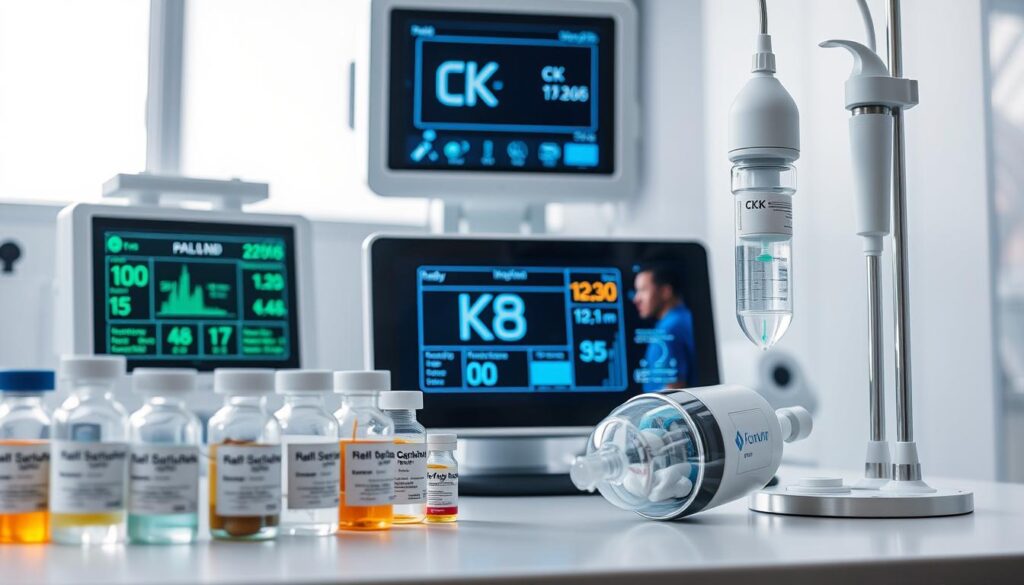
Prevention Strategies and Long-term Management
Keeping creatine kinase levels normal is key to staying healthy. Prevention strategies like regular exercise and a balanced diet are important. Also, avoiding too much physical strain helps.
Long-term management means watching creatine kinase levels and adjusting treatments as needed. Making lifestyle changes can also help.
Some important steps for prevention strategies and long-term management are:
- Regular physical activity to keep muscles healthy
- Eating a balanced diet with nutrients for muscles
- Avoiding too much physical strain or injury
- Checking creatine kinase levels and changing treatments if needed
Using these prevention strategies and long-term management methods can lower the risk of abnormal creatine kinase levels. It helps keep muscles in top shape.

| Prevention Strategy | Description |
|---|---|
| Regular Exercise | Maintains muscle health and reduces risk of injury |
| Balanced Diet | Provides essential nutrients for muscle function |
| Monitoring Creatine Kinase Levels | Helps identify and manage abnormal levels |
By being proactive with prevention strategies and long-term management, people can keep their creatine kinase levels healthy. This reduces the risk of related health problems.
Conclusion: Taking Control of Your Creatine Kinase Health
Understanding and managing your creatine kinase (CK) levels is key to good health. This guide has shown how CK is important, why we should watch its levels, and what affects them. By knowing the signs of abnormal CK and getting medical help when needed, you can protect your health.
If you’re an athlete, have a medical condition, or just want to feel better, knowing your CK levels is essential. Healthy habits like regular exercise and a balanced diet can keep your CK levels in check. This helps avoid serious problems like heart disease.
FAQ
What is creatine kinase and what is its role in the body?
Creatine kinase is an enzyme found in muscles, heart, and brain. It helps store and quickly release energy for muscle contractions. This makes it key for muscle function.
Why is it important to monitor creatine kinase levels?
Watching creatine kinase levels helps spot muscle damage or disease early. Changes in levels show how much muscle is injured and how diseases progress. It’s a key tool in medical diagnosis.
What is the normal range for creatine kinase, and how can it vary?
The normal range for creatine kinase varies slightly by lab but generally stays within a certain range. This range can also change based on age and gender.
What factors can influence creatine kinase levels?
Many things can affect creatine kinase levels. These include physical activity, muscle diseases, and some medications. Knowing these factors helps when looking at test results.
What are the signs and symptoms associated with abnormal creatine kinase levels?
Abnormal levels can cause a range of symptoms. These symptoms can vary in severity and type based on the cause. If you notice any concerning symptoms, see a doctor.
When should I get my creatine kinase tested?
You might need a creatine kinase test after intense exercise or if you have muscle damage symptoms. Avoid hard workouts and some medications before the test to get accurate results.
How is the creatine kinase test performed, and how are the results interpreted?
The test involves a simple blood draw. The blood is then analyzed to find the enzyme’s activity levels. A healthcare provider will help understand the results and what they mean.
What are the possible causes of high creatine kinase levels, and what are the implications?
High levels can mean muscle injury, intense exercise, or certain diseases. High levels can signal health issues and need further evaluation and treatment.
What are the possible causes of low creatine kinase levels, and what do they indicate?
Low levels might point to health problems. It’s important to have a doctor check and find the cause.
How can lifestyle factors, such as exercise and diet, impact creatine kinase levels?
Exercise and a balanced diet are key for healthy creatine kinase levels and muscle health. Knowing how lifestyle affects creatine kinase helps manage health better.
What natural ways can I use to maintain healthy creatine kinase levels?
Natural methods like diet changes and lifestyle tweaks can help keep creatine kinase levels healthy. A mix of medical advice and natural remedies works well.
What medical treatments are available for abnormal creatine kinase levels?
Treatment for abnormal levels depends on the cause and condition. Doctors can create a plan that might include medication, lifestyle changes, or other steps.
How can I prevent and manage creatine kinase levels in the long term?
Preventing and managing levels involves regular checks and lifestyle changes. Working with a healthcare provider is key for long-term health and creatine kinase management.